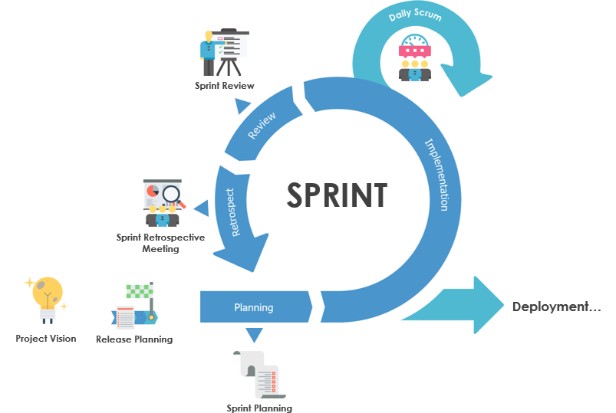In this article, we’ll discuss What Is A Sprint In Agile, the Benefits Of Sprints, and How To Create A Sprint
Businesses can use Scrum planning in an Agile methodology to successfully complete large projects. Teams use sprints as part of the Scrum framework to break down complex tasks into smaller tasks that they can complete in less time. With sprints, teams can produce high-quality work more quickly and effectively while also being able to quickly adjust to shifting requirements. This article describes an Agile sprint, explains the advantages of working in them, explains how to do it, and gives an example.
Table of Contents
What is a Sprint in Agile?
What is a sprint in Agile, you may be asking as a developer?’. In an Agile project management process, a Scrum team works in close collaboration with the project’s stakeholders over several brief iterations. Teams break down large projects into manageable chunks of work called sprints using the Scrum framework. These sprints enable the team to easily adapt to changes thanks to the Scrum methodology. Every project is divided into sprints, and each sprint is worked on by a different member of the team. A sprint can last for up to four weeks. The most frequent sprint duration is typically two weeks.
Development teams work together in a Scrum meeting as the sprint progresses to monitor their progress and, if necessary, make adjustments. To assess the quality of the work produced, development teams conduct sprint reviews. Teams use comments and feedback to create the following sprint strategy after sprint reviews.
How Long is a Sprint?
Generally speaking, sprints last no more than one month. While some teams may prefer working in two-week sprints, others may prefer weekly sprints. Monthly sprints may be more appropriate for larger, more complicated projects as they give contributors more time to complete tasks and present their achievements.
Now let’s think about how to sprint project management functions.
Six two-week sprints could be used to complete a website launch project that would normally take three months. During sprint one, your goals might include:
- Hosting setup
- Theme installation
- Sitemap creation
- Content interviews/research
These kinds of tasks frequently have the feeling of pre-work, which team members are eager to finish so they can concentrate on the project’s main objectives. However, if you reframe them as the objectives of your first sprint, not only will you ensure that the project gets off to a strong start, but you’ll also give the team members a sense of early success as they prepare for the later, more intense work.
What is the Sprint Cycle?
Every time you manage and plan a sprint, you’ll follow a cyclical process known as a sprint cycle. The process’s steps won’t change; what will change are the insights you gain at the end of a sprint and how you use them to make the subsequent sprint even more productive.
There are four stages, also called Scrum ceremonies, that the project manager takes ownership of within each sprint, including sprint planning, check-ins, reviews, and retrospectives:

Sprint Planning.
Proper sprint planning is necessary before starting a sprint. This is the project manager’s chance to choose the goals and tactics for the subsequent sprint. The project manager gathers the team to determine:
- How much work can be completed within one sprint
- And how it will be completed
A crucial component of sprint project management is the sprint backlog, which is a list of goals.
The amount of work should be sufficient to fill the time available, but not excessive.
- lacking sufficient planning. can cause the project to run over budget and schedule.
- Too much work is put into planning. can result in team burnout and missed deadlines.
Your planning ought to ideally happen in a centralized project management tool like Adobe Workfront.
Select a system that enables you to manage your projects using an Agile methodology and provides a work board for hosting sprints and backlogged tasks.
Daily Scrum.
Daily Scrum meetings, also referred to as stand-up meetings, make sure that sprints proceed as planned and that everyone on the team is informed when issues arise. Sprint stand-ups typically only last 15 minutes and require each team member to:
- Discuss what they’ve accomplished since the last meeting
- Explain what they’ll work on before the next meeting
- Detail any obstacles are standing in their way
Daily stand-ups should only last a few minutes. If longer meetings are necessary, they should be planned separately from stand-ups.
Sprint Review.
Once a sprint is completed, the project manager hosts a sprint review meeting with all team members and stakeholders to:
- Demonstrate sprint outputs
- Determine what was accomplished and what wasn’t
- Review project forecasts
Untested or incomplete work is not displayed; rather, it is kept for the planning phase of the subsequent sprint.
Sprint Retrospective.
Sprint retrospective is the last stage of the sprint project management process. This occurs following the sprint review and before the following sprint planning meeting.
Team members can discuss successes and difficulties from the prior sprint during this collaborative meeting in order to change processes as necessary. One issue at a time should be fixed, and incremental, small changes should be made from sprint to sprint.
Sprints Vs. Scrums.
Sometimes, the terms “sprint” and “Scrum” get confused, but they describe different things.
- Sprints. These are quick, recurring time intervals during which the project’s essential components are finished. A Scrum methodology includes them.
- Scrum. An agile project management methodology that uses predetermined procedures and guidelines, such as sprints, to improve collaboration.
Because they enable the division of projects into manageable portions, sprints are frequently regarded as the core of any Scrum methodology.
Sprints Are at the Heart of Scrum Approaches.
Project sprints are crucial components of any Scrum-based project. These time boxes are used to:
- Accomplish small chunks of the larger overall project
- Keep your team focused on what’s in front of them
- Build and sustain momentum
- Prevent anyone from feeling overwhelmed
The sprint mentality naturally adapts your processes as you go, and reviewing sprints after they are finished helps produce new insights and offers opportunities to celebrate each small victory along the way.
What Are the Benefits of Sprints?
Teams can effectively manage big, complex projects by working in sprints. By breaking down the project into smaller, more manageable tasks, it is possible to guarantee the quality of a product and deliver it on time. This also enables the teams to adapt to adjustments and criticism as needed. Here are some advantages of working in sprints:
Increases Focus on Quality
Sprint reviews must include quality control. Review meetings offer chances to present finished work and receive input from others. At the conclusion of each sprint, team members gather for retrospective meetings to review the results of the iteration, identify areas for improvement, and make adjustments for the following one. This method will enable the team to produce a product of higher quality.
Enhances Productivity
Sprints work well because they keep everyone’s attention on a single task at a time. Through repeated iterations, the product can be continuously improved. The team’s productivity has increased as a result, which is good.
Reduces Costs
Numerous resources are needed for large projects, which could take a while. Additionally, altering client needs may necessitate substantial project changes that add time and money to the project. With sprints, teams can more easily adjust to changing requirements, and previous sprint tasks can still be completed despite significant changes in the current sprint. Both project costs and timelines are significantly shortened as a result.
Increases Collaboration
To produce a high-quality product, the team must work together. Agile methodologies place a lot of importance on teamwork and self-management. Agile sprints promote frequent team collaboration and cooperation as a result. All team members will have the chance to learn from one another, which will improve the group’s performance as a whole.
Minimises Risks
During an Agile project sprint, a team has several chances to address a potential problem before it develops into a major problem. To stay informed and focused, team members benefit from daily stand-ups and updates. They already have a practical solution in place in case they encounter a similar issue in the future. Teams can run numerous feedback loops when using Agile project sprints, which enables them to quickly identify and address potential issues.
Transparency
On an Agile team, everyone exchanges information and has a similar understanding of the final product. The team members can update the status of their tasks using issue tracking software, which is accessible to everyone working on the software development project. Increased visibility and transparency are guaranteed by team members’ alignment with their duties and responsibilities.
Who Uses Sprints?
Utilizing the Scrum framework and planning sprints to complete tasks can be beneficial for development teams. An employee involved in a Scrum project can be in the following categories:
Product Owner
An essential member of the Scrum team, the product owner’s main duty is to collect client requirements and communicate them to the development team. The product owner can make sure that every Scrum decision is in line with the needs of the company by being aware of its production requirements. Their responsibilities usually include:
- Tracking resources and tasks during each sprint
- Following up on changes in requirements
- Keeping stakeholders informed and providing clear guidance to the team
Scrum Master
A Scrum master facilitates communication between the development team and the product owner. Product owners and scrum masters meet to talk about expectations and create concrete rules. They assist both parties in developing ideas and achieving the desired result. They typically perform the following duties:
- Help the product owner define the project’s values
- Help the owner and team prioritise phases in the sprint
- Provide guidance on how to maximise productivity in each sprint
- Host daily stand-up calls to review the progress and address any issues
Development Team
Typically, members of the development team are involved in Scrum planning projects. They are aware of the specifications, adhere to the rules, and create products that satisfy customers. During a sprint, a task might be worked on by several people at once or it might be finished by one person alone and then integrated into the overall workflow.
5 Steps on How to Create a Sprint
Follow these steps to create a sprint:
1. Plan the Sprint
When a new sprint begins, the team holds a sprint planning meeting. This meeting is attended by the product owner, the product owner’s representative, and the scrum master. The project’s product owner helps to prioritize tasks in the project’s backlog by talking about it. The development team chooses which items from the backlog to complete during each sprint. Team members come up with plans to finish tasks that are waiting to be done and, if necessary, adapt to changing requirements. They transfer the tasks from the project backlog to the sprint backlog during the sprint and concentrate on finishing those tasks.
2. Monitor the Progress
Staff members can track the team’s progress and address any issues they may have thanks to daily check-ins during the sprint. The informal meeting, which starts the workday, takes place at that time. In this meeting, the staff members report on their current projects and daily schedules. Participants may suggest alternatives to current problems, voice concerns, and offer solutions to increase the effectiveness of the work.
3. Focus on Execution
The execution phase receives the majority of the teams’ sprint time. This includes all work the team does to complete the sprint backlog, and it lasts the duration of the sprint. Team members communicate expectations and talk about how to optimize operations during daily Scrums. Typically, the product owner gives the team feedback, responds to inquiries, offers direction, and evaluates interim work. When unexpected events occur or if the client requests a change, the product owner may also talk about modifying the sprint goal.
4. Conduct the Sprint Review
This review assesses the product’s newest features as well as its future development plans. Better visibility, control, and risk management are made possible here as compared to traditional software development life cycles. Here is the agenda for a typical sprint review meeting:
- Welcoming the stakeholders
- Presenting the agenda for the sprint review
- Showcasing the demo built by the team during the execution phase
- Obtaining feedback from the stakeholders
- Reviewing the product backlog and getting feedback and recommendations for the upcoming sprint
- Concluding the meeting with action items and setting the date of delivery
5. Sprint Retrospective
After the sprint review and before the subsequent sprint planning, sprint retrospectives take place. Members of the development team, the product owner, and the Scrum master are present. During this meeting, the team reviews past errors, addresses concerns, identifies areas of improvement and prepares a plan to implement them in the next sprint
Example of a Sprint in An Agile Framework
The long-term objective of an organization is its product vision. Product goals are the transitional objectives that assist the organization in getting to its ultimate vision. Sprint goals are the steps in between that make up product goals. Teams establish the sprint goals during the sprint planning phase, and they are evaluated during the sprint retrospective phase. The sprint goals may alter as the requirements and product issues do. The tasks that the Scrum team has listed are in the sprint backlog.
Below is an example of a sprint using an Agile framework:
- Product vision: To offer the pipeline industry defect detection solutions.
- Product goal: to create a deep learning model to analyze images and find pipe flaws.
- Sprint goal: to increase the model’s accuracy to over 95%. to improve the usability of the user interface (UI).
- Sprint backlog: By enhancing the training dataset, implementing transformations, and utilizing transfer learning, the model can be trained to achieve more than 95% accuracy. Make the home page more user-friendly by redesigning it and clearing out the clutter.
Conclusion: a Sprint in Agile
A development team works to complete specific tasks, milestones, or deliverables during a project sprint in Scrum. Project timelines are divided into smaller, easier-to-manage blocks by sprints.
When working on a six-month project, it can become tedious and make Agile team members feel as though they are not making any progress, even though they actually are. Instead of waiting until the end of the project to set smaller goals and individual KPIs, divide your project plan into sprints. Because of this, sprint project management is a crucial tool and set of abilities.




